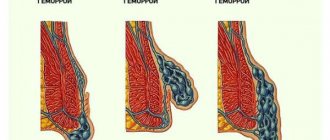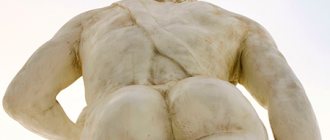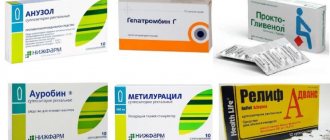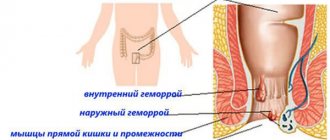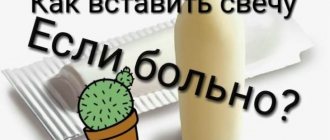For the most part, all diseases of the anus and rectum cause significant inconvenience to a person. And this suffering brings not only physical, but also psychological discomfort. Of course, pain, itching, burning in the anus, and bleeding in themselves are extremely unpleasant. But there is also psychological discomfort associated with the difficulties of solving the problem, the problems of discussing it, and the search for a specialist who can help. Often the problem is the fear of making the disease public, of “dishonoring” in the eyes of others.
This makes it difficult to solve the problem and puts it on the back burner. But, like any disease, diseases of the anus and rectum do not go away on their own. Small hemorrhoids become larger over time. And this time is different for everyone. An acute anal fissure turns into a chronic one, and surgery cannot be avoided. A small anal fringe grows, and the problem turns from an aesthetic one into a physical one - the fringe becomes inflamed and hurts. And so on. The list of such situations can be extended.
Any doctor knows many stories when a disease could be cured quite easily at the beginning of its development and required a lot of work between the doctor and the patient when it was advanced.
What are external hemorrhoids? A little anatomy
External hemorrhoids (plexuses) are formations located under the skin on the border of the anal canal and perianal (around the anus) skin. They are venous plexuses (Fig. 3). Usually they do not manifest themselves in any way, are not visible and cannot be detected by touch. As the condition worsens chronically
changes occur in internal hemorrhoids and in external hemorrhoids, leading to their enlargement and loss of connection with the muscular ring of the anal canal. However, the most significant changes in the external nodes occur when a blood clot occurs in them.
Rice. 3. Diagram of the anal canal, at the exit of which the external hemorrhoids are located (number 7 in the diagram).
Microclysters
To treat hemorrhoidal cones with the internal form of the disease, it is recommended to use traditional methods of treating hemorrhoids in the form of microenemas. This type of therapy allows you to have a therapeutic effect on the affected areas, relieve pain, inflammation, and stop bleeding.
For microenemas use:
- decoctions of medicinal herbs;
- honey;
- freshly squeezed juices of potatoes, carrots, beets;
- natural oils (sea buckthorn, calendula, juniper, sage, chamomile and others);
- potassium permanganate solution.
Microenemas based on medicinal herbs are indicated for internal hemorrhoids
To administer an enema, the patient needs to lie on his side, inject a medicinal substance into the anus using a syringe, and try to retain the liquid for 3–5 minutes. Before carrying out the procedure, you must make sure that you are not allergic to a particular type of medication.
How does acute thrombosis of the external hemorrhoid manifest?
Patients with acute thrombosis of the external hemorrhoid complain of a protrusion, “bump” (neoplasm) and/or pain of varying intensity in the anus. The size of the “bump” can range from several millimeters to several centimeters and is often accompanied by swelling of the surrounding tissues (up to the entire circumference of the anal canal). In some patients, the disease proceeds without pain, but most assess the pain as significant or unbearable.
To assess the degree of pain, a special visual analogue scale is used, in which you can independently determine the severity of pain. After all, this is the key point when choosing a treatment method. Surgical treatment will be most effective when the severity of pain is 7 or more points, while for pain up to 4 points, a conservative method of treatment can be considered optimal.
Rice. Visual analogue scale for pain assessment.
Pain usually worsens during bowel movements and/or sitting. The pain and swelling can be severe, even unbearable for several days. The intensity of pain depends on the size of the blood clot and its location in relation to the anal sphincter muscles. In general, manifestations of the disease can persist for several weeks, in exceptional cases longer. Sometimes spontaneous evacuation of a blood clot from a hemorrhoid occurs. This is preceded by necrosis (destruction) of the skin over the thrombus, and the thrombus seems to “fall out” of the node. Externally, this is accompanied by the sensation of a “bursting” ball and the release of a small amount of blood. Usually, after evacuation of the blood clot, the pain and discomfort in the anus gradually decrease. However, necrosis of the mucous membrane above the thrombus does not always end only with the evacuation of the thrombus; necrosis can continue to spread to the hemorrhoid itself and surrounding tissues, which is why this condition requires consultation with a specialist. After acute thrombosis subsides, the patient is most often left with so-called “skin fringes” - excess skin where the thrombosis was. They do not require medical treatment, but may cause cosmetic discomfort.
Herbs for hemorrhoids
Folk remedies for hemorrhoids often include medicinal herbs in recipes. They are available, used as decoctions, infusions - water or alcohol - for external and internal use. The use of herbs helps:
- reduce pain;
- eliminate tissue swelling;
- speed up healing;
- stop inflammation;
- strengthen the walls of blood vessels;
- reduce the size of nodes;
- relieve itching, burning;
- prevent the development of infection;
- strengthen the immune system;
- constrict blood vessels;
- relieve spasms;
- reduce bleeding.
Treatment of hemorrhoids with herbs depends on the symptoms and degree of damage. It is better when everything is agreed with the doctor. They are used as part of preparations or separately - each acts on its own symptoms. Herbs used in folk remedies recipes:
- common mullein;
- knotweed;
- sagebrush;
- pharmaceutical camomile;
- steelweed root;
- horse chestnut
Chamomile for hemorrhoids
The use of this plant is very effective, but is prohibited for pregnant women. Chamomile has a healing effect for hemorrhoids due to its antiseptic effect. When used in decoctions, infusions for internal and external use:
- inflammation goes away;
- pain decreases;
- itching is eliminated;
- spasms are removed;
- the bleeding stops.
Chamomile infusion is used for hemorrhoids in microenemas, lotions, and baths. To prepare, leave a glass of boiling water with 3 tablespoons of herbs under the lid for an hour. Gauze dressings with a solution that are kept in place for 15 minutes are effective. You can make candles according to this folk recipe:
- cut off the little finger of a rubber glove;
- pour in the infusion;
- tie;
- to freeze;
- put it on overnight.
Onion for hemorrhoids
In folk recipes for the treatment of hemorrhoids, onions are often used. At the initial stage, it is recommended to make juice from it. Take the composition three times during the day, and you can add the same amount of water or honey to one spoon. Homemade rectal suppositories made from oblong onion sets are effective. It is first kept for a day in honey.
Onions are used for hemorrhoids and other uses in folk remedies:
- The benefits of turpentine baths for joints, and can they cause harm?
- sitz baths with brewed husks - relieve burning, pain, itching;
- onions baked in a frying pan, if you make compresses with them every day, reduce the size of the nodes;
- They act quickly - I reduce pain and burning - steam baths prepared from a couple of onions, stewed in two liters of milk for 2 hours in the oven.
Yarrow for hemorrhoids
A popular and affordable medicinal herb, yarrow, is used in folk remedy recipes for many diseases. This happens due to its exceptional properties - antibacterial, analgesic, hemostatic. Using:
- nodes dissolve;
- spasms are relieved;
- swelling decreases;
- wounds heal;
- inflammation is relieved.
Since the spectrum of action of the medicinal plant is very wide, it is advisable to first coordinate its use with your doctor. Yarrow is used in folk recipes for the treatment of hemorrhoids in a comprehensive manner:
- brew and drink tea - 2 tablespoons of leaves are needed for a liter teapot;
- make microenemas with a decoction;
- apply lotions with alcohol tincture.
Kalanchoe for hemorrhoids
The leaves of the house plant are used freshly cut. You can activate the beneficial properties of Kalanchoe if you keep the raw material in the refrigerator for a week. This medicinal plant as part of folk remedies helps:
- reduce inflammation;
- prevent the development of infection;
- heal cracks and wounds;
- relieve swelling;
- reduce bleeding.
Thanks to its antibacterial, analgesic and hemostatic properties, hemorrhoids are quickly treated. The following methods of using Kalanchoe are recommended:
- applications from plant juice diluted three times with water;
- applying a crushed sheet of paper to the outside;
- using a twisted turunda made of gauze soaked in juice as a candle.
What causes acute thrombosis of the external hemorrhoid?
The occurrence of thrombosis is often caused by overflow of the veins of the external hemorrhoidal plexus with blood, followed by a slowdown in blood flow in these vessels and the occurrence of blood clots. Thrombosis against the background of venous congestion most often develops after sudden or prolonged stress. Classic examples of such overexertion are heavy lifting, straining during constipation or diarrhea, and childbirth. Chronic stagnation of blood in the pelvic organs (which includes the anal canal) occurs with prolonged sitting, excess body weight, and insufficient physical activity.
How to distinguish acute thrombosis of the external hemorrhoid from other diseases?
Usually, to diagnose acute thrombosis, it is enough to examine the patient and find out how the disease developed and what complaints are of concern. Upon examination, you can see an enlarged (sometimes up to several centimeters) node, often dark red in color, located outside the anus, possibly with a focus of necrosis in the center. When palpating (feeling) in the first few days, you can clearly identify a blood clot in the node; when examined at a later date, the blood clot is no longer so easy to determine; it begins to gradually “dissolve” and is partially replaced by scar tissue. Thrombosis of the external hemorrhoid must be distinguished from
strangulation of a prolapsed internal hemorrhoid. In this situation, prolapse of the internal hemorrhoidal node, normally located inside the anal canal, compression of its pedicle, in which the vessels feeding it pass, and disruption of the blood supply (ischemia) with death of the tissue of the node (Fig. 4 and 5). It is not difficult for a specialist to distinguish between these conditions, but it is quite difficult for a patient to independently understand which node is causing him discomfort. It is important to distinguish between these diseases, as their treatment varies significantly. When an internal hemorrhoid is strangulated, urgent surgical treatment is usually required.
Rice. 4. A strangulated prolapsed internal hemorrhoid with signs of tissue necrosis of the node.
Fig.5. Schematic representation of a strangulated internal prolapsed hemorrhoid.
Acute (exacerbation of chronic) anal fissure - accompanied by the same pain syndrome as with thrombosis, but much more pronounced at the time of bowel movement. With this disease, a rupture of the anal canal mucosa occurs. The appearance of an acute fissure is often associated with a reflex “protective” spasm of the sphincter apparatus, which complicates wound healing. Conservative and surgical treatment of diseases are different.
Acute paraproctitis - similarity with acute thrombosis lies in the appearance of a space-occupying formation in the anus, severe pain. Paraproctitis is an infectious and inflammatory disease with the formation of an abscess (abscess) in the pararectal area. The disease is accompanied by an increase in body temperature and general symptoms of intoxication. A mass formation in the anal canal area is much larger and more painful than with thrombosis. There is often discharge of pus onto the skin or into the lumen of the rectum. Ultrasound examination is used for accurate diagnosis. The disease is extremely dangerous due to the development of chronic purulent fistulas of the perianal area in the absence of adequate and timely treatment.
Homemade candles
Another type of treatment that traditional medicine offers for hemorrhoids is homemade suppositories. This is a traditional method that helps to quickly relieve symptoms of the disease and soothe inflamed tissues.
Potato fruit suppositories
To prepare candles, you need to take a vegetable, peel the peel, and cut out oval-shaped suppositories from it. Before insertion, the candle must be lubricated with oil. Olive, sunflower, sesame and others are suitable. This method is suitable for the treatment of hemorrhoids in women and men and does not cause allergies or irritation. The suppository is left overnight. You can use carrots instead of potatoes.
Potato suppositories relieve pain, burning, swelling and other manifestations of the disease
Ice candles
During therapy with traditional methods, ice suppositories will help to quickly relieve pain and stop bleeding. Cold promotes constriction of blood vessels and capillaries, provokes the outflow of blood, which is necessary to eliminate signs of the disease. Prepare candles in pre-prepared forms made of parchment paper or cardboard. The molds need to be filled with water and placed in the freezer. Before insertion, the suppository is dipped in warm water for a few seconds, then inserted into the anus.
Is it always necessary to treat acute thrombosis of the external hemorrhoid?
The choice of treatment method for this disease is one of the most controversial issues in general proctology. Like hemorrhoids, acute thrombosis does not turn into cancer, does not cause deadly complications, but can significantly affect the patient’s quality of life; the pain syndrome is often described as “unbearable”, with which it is “simply impossible to live.”
Our Clinic has adopted a patient-centered approach to choosing a treatment method for acute thrombosis of external hemorrhoids: the doctor, together with the patient, determine how severe the symptoms are, how much the patient’s quality of life suffers, taking into account his employment, and choose a treatment method.
Acute thrombosis of the external hemorrhoid can be treated promptly (perform surgery), conservatively (take pills and use topical ointments and/or suppositories) or not treat at all, but choose a wait-and-see approach. Research and practical experience show that surgical treatment allows you to get rid of the manifestations of the disease in a shorter time; conservative treatment also allows you to get rid of the manifestations of the disease, but over a much longer time. The absence of any treatment also ends with recovery, the timing of which differs only slightly from the timing of intensive conservative treatment. The determining factor in the choice of treatment method is the patient’s choice and his assessment of the severity of the pain syndrome, therefore, the patient’s opinion is crucial for the choice of tactics. If the patient assesses the pain as unbearable, or he urgently needs to return to work, fly to another city or country, it is more reasonable to choose surgical treatment in the scope of removing the hemorrhoidal node or evacuating the blood clot from the node. Surgical treatment usually leads to faster relief of unpleasant symptoms. If the pain syndrome allows the patient to live fully in this condition or the patient is not ready for surgical intervention, it is possible to carry out conservative treatment aimed at reducing the pain syndrome and accelerating the process of organizing and resolving the blood clot.
Fighting methods
Everyone has wondered how to treat hemorrhoids and what the most effective recipes are. There are many ways to treat the disease. So, hemorrhoids are treated with traditional methods and its consequences, too, starting with medications and ending with surgical intervention. Each of the available factors is individually tailored to each person. But alternative medicine is effective in this matter. This method will not hit your wallet, will not take much time and will not force you to leave your comfort zone.
An important advantage of healing at home is its ease of use and effectiveness, showing good results over many years. And regular hemorrhoid therapy with folk remedies can get a good effect.
How to treat acute thrombosis of external hemorrhoids?
Possibilities of surgical treatment
There are two main operations for the treatment of acute thrombosis of an external hemorrhoid: removal of the entire node or just the thrombus from it. The first operation is called economical (partial) hemorrhoidectomy (removal of only the external hemorrhoid), the second is thrombectomy. Both operations are effective in terms of eliminating pain within 2-3 days after their implementation, however, after an operation to evacuate a blood clot, a relapse (reoccurrence of a blood clot) is more common.
Economical (partial) hemorrhoidectomy of a thrombosed node involves incision of the skin around the node, its isolation and removal along with the thrombus. The operation can be performed under local anesthesia.
After removal of a hemorrhoid, a small wound surface is formed, which can cause pain, especially during bowel movements. But usually the pain is much less pronounced than in the presence of a thrombosed node, and only sometimes requires taking tablet painkillers.
Thrombectomy is performed through a skin incision over the thrombus, after which the thrombus is removed and 1-2 sutures may be placed at the incision site. This intervention is almost always performed under local anesthesia.
Conservative treatment
Conservative treatment (tablets and local remedies - ointments and suppositories) is mainly aimed at relieving pain caused by a blood clot, reducing swelling and inflammation of the hemorrhoid, and normalizing the frequency and quality of stool. Pharmacies offer a large number of drugs for the treatment of hemorrhoidal disease, but they are all approximately equal in effectiveness and can be used to treat acute thrombosis of the external hemorrhoid. Local remedies (ointments and suppositories) mainly have an analgesic and anti-inflammatory effect. Topical agents with an anticoagulant effect in the treatment of acute thrombosis are effective only for the temporary prevention of new blood clots or, if the drug contains an analgesic component, for pain relief. Tablets are also used for pain relief (non-steroidal anti-inflammatory drugs, paracetamol) and normalization of venous blood flow in the pelvis (in the rectal area), for example, flavonoids. In addition, conservative treatment is also carried out after surgery to eliminate possible postoperative symptoms. A conservative treatment regimen can only be determined by a specialist, and it is better to select a combination of drugs in each specific case, depending on the characteristics of each patient.
Recipes for bleeding
Traditional recipes will help you cope with rectal bleeding.
Recipes for the treatment of hemorrhoids with bleeding are intended for oral administration and are prepared from available ingredients:
- The best and most effective remedies for treating hemorrhoids
- Grind horse chestnut fruits weighing 50 grams and pour in 0.5 liters of vodka. Leave for 2 weeks in a dark place. A tablespoon of the finished tincture should be diluted with 80 ml of boiled water before ingestion. The medicine is taken in the morning before breakfast.
- Grind dry hazel leaves weighing 50 g into powder, pour 0.5 liters of boiling water and wait until it cools. You need to drink the tincture 4 times a day before meals, 100 ml.
- Grind 60 g of dried rose hips, pour into a thermos and pour 600 ml of boiling water. It is advisable to make the infusion in the evening, and in the morning strain and drink during the day in three doses. You can mix honey into it.
Home remedies for hemorrhoids are taken until the symptoms of the disease disappear completely.
What will happen after the operation?
Typically, patients feel dramatic relief after surgery and note a decrease in pain (Fig. 6). Sometimes continued minimal pain therapy is required. The main task of the patient in the postoperative period is to normalize stool: soft stool causes much less pain during bowel movements than dense stool. As a rule, patients return to their normal lives 2-3 days after surgery, sometimes the very next day.
a) b)
Rice. 6. View of the anus before (a) and immediately after removal of the external hemorrhoid (b). Before the operation, the patient rated the pain level as 8 out of 10, immediately after the operation it was 4 out of 10.
Ointments and compresses
For the purpose of cure, most patients choose the use of herbal medicine, with the participation of which an ointment is subsequently prepared. We take oak bark, toadflax inflorescences and water pepper grass in a ratio of 2:5:3. You can use rendered lard or full-fat sour cream as the fat base. Then the entire composition must be heated for 12 hours over low heat. Then the future cream is passed through a sieve and poured into molds. The ointment is used by inserting it into the anus in the form of a tampon soaked in cream and leaving it in this position for up to 5 hours.
Ointments prepared at home from natural ingredients cope with the manifestations of external hemorrhoids, reduce pain and size of hemorrhoids
Are there ways to prevent relapses/recurrences of the disease?
Prevention of relapse of the disease is based on excluding possible causes of thrombosis. These include hard stools, constipation or diarrhea, “reading on the toilet,” insufficient or, conversely, excessive physical activity (weightlifting, fitness), and prolonged sedentary work. Unfortunately, there are no unambiguous methods for preventing the occurrence of acute thrombosis of the external hemorrhoid; we can only reduce the likelihood of its occurrence, but not completely eliminate it. However, it should be noted that with conservative treatment the likelihood of recurrence of the disease is higher than after operations.
What should pregnant women and postpartum women/mothers with acute thrombosis do?
According to statistics, about a quarter of pregnant women and almost half of postpartum women experience various manifestations of hemorrhoidal disease, the most painful of which is acute thrombosis. Usually, postpartum women and especially pregnant women, in response to their complaints to the doctor, hear an offer to be patient. This approach is dictated by the fact that there are many contraindications to the use of the vast majority of medications in pregnant women, and surgical intervention is regarded by the medical community as a factor that can provoke childbirth or stop the process of breastfeeding. In practice, this means that regardless of the severity of the pain syndrome, sometimes very significant, women are forced to remain without any effective treatment. Pain due to thrombosis, in turn, can worsen the psychological state of pregnant or postpartum women and lead to undesirable consequences during childbirth (premature birth) or during breastfeeding (refusal to breastfeeding). Our clinic is a supporter of a personalized approach to the treatment of acute thrombosis in such women. If acute thrombosis categorically prevents the patient from living, it should be actively treated using the entire arsenal of means used in ordinary patients, but taking into account contraindications for medications. In pregnant women in the second and third trimesters, it is possible to perform an operation to remove a thrombosed node (Fig. 7), as well as in postpartum women and women in labor (Fig. 8). During pregnancy, there are some restrictions on the local and general anesthetic drugs that can be used. Specific medications should be selected jointly by both the coloproctologist and the obstetrician so as not to harm the fetus or newborn. The specialists of our Clinic have experience in treating both pregnant and postpartum women with manifestations of acute thrombosis of the hemorrhoid with very good results, reviews of which our patients leave on our website, among other things.
a) b)
Rice. 7. Acute thrombosis of the external hemorrhoid in a 38-week pregnant woman.
Before surgery, pain was rated 8 out of 10, immediately after surgery 3 out of 10.
a) appearance of a thrombosed external hemorrhoid with necrosis, b) appearance after removal of the thrombosed node.
a) b)
Rice. 8. a) acute thrombosis of the external hemorrhoid with severe swelling in the patient on the 5th day after birth, b) the patient’s condition on the 7th day after surgery. On the first day after surgery, pain decreased from 9 to 4 out of 10.
You can read about the treatment of other manifestations of hemorrhoidal disease in pregnant women and postpartum women in the section Hemorrhoids in pregnant women .
Baths for hemorrhoids
Taking sitz baths with medicinal decoctions is indicated for hemorrhoids without bleeding, acute inflammation, or large nodes. The purpose of the baths is to relieve pain, speed up healing, and disinfect the anal area. Take baths after defecation and hygienic washing.
Based on temperature they are distinguished:
- hot baths with a temperature of 45-50°C are indicated for the initial stages of hemorrhoids, they heal, relax, and relieve pain. Sit in a hot bath for 5 minutes;
- warm baths correspond to a temperature of 35-40°C, are effective at stage 2 of hemorrhoids, exposure in the bath is 10 minutes;
- cool baths are taken at a temperature of 25-30°C for stage 3 hemorrhoids. Cool washing dulls pain and reduces inflammation. The duration of the bath is 5 minutes. You should not sit longer in cold water to avoid inflammation.
For baths, brew celandine, oak bark, sweet clover, tansy, and cinquefoil erecta. Five tablespoons of dry raw materials are brewed in 3 liters of boiling water. After an hour, the broth is filtered, cooled to the desired temperature and poured into a basin. The procedure is done at night. After the bath, dry the anus and lubricate it with sea buckthorn oil. Baths are contraindicated for pregnant women and women in labor.
Baths with steam and smoke
In addition to classic baths with herbal infusions, the arsenal of folk remedies for hemorrhoids includes smoke and steam baths. Their use requires some experience and skill. The material for such baths is birch tar. This anti-inflammatory, disinfecting and healing folk remedy does not dissolve in water, is difficult to wash off the skin, and irritates the mucous membranes upon direct contact. For the procedure you will need: a 10 liter heat-resistant bucket, a brick, a wooden lid for the bucket with a hole for steam. The lid must support the weight of a person; you will have to sit on it.
- How to stop bleeding from hemorrhoids - a scheme for effective treatment with hemostatic drugs
Steam bath
Pour a liter of boiling water into the bottom of the bucket, add a tablespoon of tar, stir as much as possible. Close the bucket with a lid, sit on the lid so that the steam gets to the sore spot. If the steam is too hot, wait for a comfortable temperature. Sit on the lid until the steam runs out.
What to do if you have undergone a course of conservative treatment for thrombosis
The abundance of means for the conservative treatment of thrombosis and often the doctor’s disposition to use this technique leads to the fact that most thromboses are treated conservatively. Patients come to our Clinic at different stages of the course of conservative therapy. Often this is a situation where, immediately after the occurrence of a blood clot, conservative therapy was started, some relief of the condition occurred, the pain syndrome decreased, but a “bump” remains in the anus and some pain. Sometimes completely healthy people come in who experienced an episode of acute thrombosis several months or years ago and are now concerned about the presence of skin “fringes,” excess skin in the anus that remain after the acute condition has resolved. They can interfere with the proper hygiene of this area and affect intimate life. What to do in this situation? And again, the main thing for the doctors of our Clinic will be the patient’s opinion. If you want to get rid of the manifestation of acute thrombosis, even if conservative treatment has already been carried out, a lot of time has passed - this can be done surgically.
Removal of anal fimbriae
Another important problem that many patients (most often women) treat is anal fimbria. They ask to remove them. What are these fringes? This is the “extra” skin that appears at the edge of the anus. It always gets in the way, causes aesthetic problems, and often becomes inflamed and grows.
Anal fimbria are always associated with diseases of the anal canal: hemorrhoids, inflammation of the canal - sphincteritis, anal fissures. Without eliminating these causes, removing fringes is pointless and sometimes harmful. They will then grow again. Dear patients, remember this when you insist on removing fimbriae!
What to consider when choosing a doctor and medical institution
If you are looking for a medical institution where to go for consultation and treatment of acute perianal thrombosis, then you need to pay attention to several factors.
- The institution has a proctological, and not just a general surgical or oncocoloproctological specialization.
- Knowledge of the Clinic staff about all possible methods of treating acute perianal thrombosis
- Possibility of performing minor coloproctological operations in a hospital setting at the Clinic
- Possibility of performing surgical treatment in the Clinic for “special” groups of patients - pregnant women, patients of the older age group


